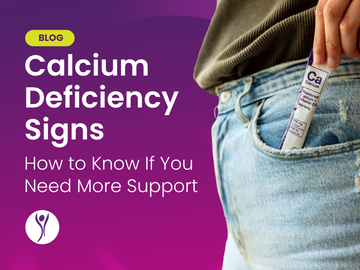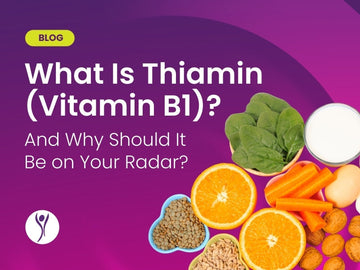How to Understand the New Nutrition Labels Part II: Vitamins and Supplements
by Anthony Benjamin on Oct 12, 2022

How to Understand the New Nutrition Labels Part II: Vitamins and Supplements
 Earlier this year, the Food and Drug Administration (FDA) changed the regulations for nutrition and supplement labels. These new labels will be easier to understand and help people make more informed choices about their food, vitamins, and supplements.
Earlier this year, the Food and Drug Administration (FDA) changed the regulations for nutrition and supplement labels. These new labels will be easier to understand and help people make more informed choices about their food, vitamins, and supplements.
While it’s already on some packages, the new label will appear on most packaged foods and supplements in the United States by January 1, 2021.
At ProCare Health, we know how difficult it can be to decipher the new nutrition labels. In this article, we’ll discuss what these updated supplement labels and what these changes mean for all ProCare vitamins.
What’s Different about the Daily Value Changes?
Based on a 2000-calorie diet, the percent daily value (DV%) refers to the nutrients in one serving of food. Here are some of the changes affecting how you’ll see it written on new nutrition labels.
Changes for All Vitamins and Minerals
Vitamins and minerals will now be declared in both quantitative amounts and percent daily value. Although the rounding laws can be confusing, the rounded values for quantity and percentage can be different.
Any vitamin or mineral present at 2% or less of the daily value can be written as 0%. This number does not have to align with the quantitative amount. If the percent daily value is written as zero, the quantitative amount should also be written as zero.
For instance, the ProCare Health prenatal supplement labels have been updated, and one change is that B12 levels are calculated differently. In 2019, 2000 mcg was equal to 33,333% DV. Now, it is equal to 71,429% DV. The amount in the vitamin did not change, just how it is calculated against the new dietary standards.
Required Nutrients
Vitamin D and potassium will now be required on labels, as deficiencies of these vitamins represent public health concerns.
The FDA has said it does not expect manufacturers to stop fortifying with A and C, nor does it expect manufacturers to start fortifying with vitamin D and potassium.
What About Labels for Supplements and Vitamins?
Like nutrition labels, there will be changes made to vitamin and supplement labels. At ProCare Health, we’ve updated all our labels with the new 2020 guidelines and supplement facts.

Some of the percent values have changed, as well as how some are listed and calculated. Even though the labels may look different, the amount and formula are exactly the same as before.
For example, most nutrients in ProCare vitamins used to have a 200% DV. However, this is no longer the case because of the label changes. Some %DV have increased and some have decreased.
While there are others, the main vitamins most bariatric patients should be aware of that have changed in value/calculation are:
- Vitamin A
- Vitamin C
- Vitamin D
- Vitamin E
- Vitamin K
- Thiamine (B1)
- Niacin (B3)
- Biotin
- B12
- Folate/Folic Acid/Methylfolate
If you’re still confused by the supplement label changes, don’t worry. We’ll dive deeper into the new label changes for supplements and vitamins:
- The name and quantity of each ingredient must be listed if the daily quantity is more than one tablet.
- If there are calories in the serving, the ingredients from where the calories came from must be listed.
- “Amount Per Serving” may be listed as “Each Serving Contains”, “Amount Per X-number of Tablets”, or another equivalent verbiage.
- Choline will now be listed on labels if it’s present and equal to or greater than 2% of the daily 11 mg requirement.
- Proprietary blends should be listed as they are.
- Vitamins A, D, and E will be listed in mg or mcg.
- Sugar will now be listed as a percent daily value (%DV).
- If a vitamin or mineral is present but less than 2% of the daily value, it could be listed as 0% on the label.
- Vitamin A is now listed in RAE or Retinol Activity Equivalents.
For a more detailed discussion on the conversion changes, see Part I: How to Understand the New Nutrition Labels: Changes from the FDA.
What are the New Unit Conversions for Nutrition Labels?
Vitamin A
The daily value for vitamin A used to be in international units (IU), it is now measured in retinol activity equivalents (RAE) . With our regular Multivitamin the label used to show 10,000IU of Vitamin A, now the label reflects 3,300 mcg RAE. The percentages are also different, but the levels of supplementation did not change, just the way it is calculated.
Thiamin (B1)
For Thiamine, the % daily value changed. It decreased from 1.5 mg to 1.2 mg. With our Once Daily Multivitamin the label used to show 20 mg of Thiamine equaled 1,333%. Now with the new guidelines the label reflects 1,667% DV. Again, the levels did not change, just the recommended daily amount which causes a shift in the higher %.
Keep in mind that this supplement is recommended in higher dosages for weight loss surgery patients.
Biotin
For Biotin the % daily value changed. It decreased from 300 mcg to 30 mcg. With our Once Daily Multivitamin the label used to show 600 mcg of Biotin equaled 200%, now with the new guidelines the label reflects 2,000% DV. This is supplement is recommended in higher dosages for weight loss surgery patients.
B-12
The much talked about B12! This also had its recommended daily value decreased from 6 mcg to 2.4 mcg. With our Once Daily Multivitamin the label used to show 1,000 mcg of B12 equaled 16,667%. Under the new guidelines the label reflects 41,667% DV. This supplement is recommended in higher dosages for weight loss surgery patients. We do have a Special Formula 45 capsule that has less B12 for patients whose levels are high.
Vitamin C
The %DV of Vitamin C increased, which means the the daily recommended has also increased. The amount in ProCare Health’s vitamin did not change, but this resulted in the %DV reflected on the label to drop. Pre 2020 the label showed 130 mg = 217% DV, now 130 mg = 144%.
Niacin
Also known as Vitamin B3, this supplement is now measured in Niacin equivalents and has a new daily value of 16 mg. With our Once Daily Multivitamin the label used to show 40 mg of Niacin equaled 200%. Now with the new guidelines the label reflects 250% DV. Again, the levels did not change, just recommended daily amount causing a shift equaling a higher %.
Vitamin D
Vitamin D will also be moving from IUs to mcg on the product label, although for vitamin D we are able to list the IU amount in parentheses. As a point of reference, 1 mcg of vitamin D equals 40 IUs. The Once Daily Multivitamin contains 3,000 IU. This converts to mcg by dividing that number by 40 (3,000 IUs divided by 40 equals 75 mcg). Vitamin D3 is a supplement that is recommended in higher dosages for weight loss surgery patients.
Vitamin E
The old daily value for Vitamin E was in international units. Pre 2020 the label showed 60 IU = 200% DV. New guidelines measure and list values as milligrams of alpha-tocopherol, where 40.2 mg = 268% DV now.
The FDA has recognized there are eight different isomers of vitamin E. These isomers are split into two categories: RRR or d-alpha-tocopherol, and all-racemic or d, I-alpha-tocopherol. In the new conversion factors, natural alpha-tocopherol will be worth twice the amount of vitamin E as synthetic alpha-tocopherol.
Vitamin K
This is another supplement where the % daily value changed. It increased from 80 mcg to 120 mcg. With our Once Daily Multivitamin the label used to show 120 mcg of Vitamin K equaled 150%, now with the new guidelines the label reflects 100% DV. Again, the levels did not change just the recommended daily amount, which caused a shift in the lower %.
Folate, Folic Acid, Methylfolate
Folate is now measured in micrograms of Dietary Folate Equivalents (DFE). One mcg is equivalent to one mcg DFE, while one mcg of folic acid is equal to 1.7 mcg DFE. Formerly written as 800 mcg, the new daily value is 800 mcg DFE. Percentages stayed the same for this one.
Folate and folic acid are essential to red blood cell formation and healthy cell growth and function. Both can be found in dark green leafy vegetables, beans, peas, nuts, oranges, lemons, and bananas. Methylfolate is the active form of folic acid, this has been shown to absorb better in many patients.
Nutrients
The list of nutrients that are required on labels has also been updated.
Since Americans do not always get the recommended amounts of Vitamin D and potassium, both are now required on nutrition and supplement labels.
The daily recommended amount for Vitamin D is 20 mcg. This nutrient is essential for bone health and can be found in cheese, egg yolks, and fatty fish such as salmon and tuna. Bariatric patients have a higher recommended amount of Vitamin D, with the ASMBS stating 75 mcg is needed.
Potassium has a large daily value that increased to 4700 mg. It can be a challenging nutrient to fortify because of this. However, it’s important for lowering blood pressure and can be found in bananas, potatoes, mushrooms, peas, and cucumbers, and most sport recovery drinks. Potassium is not included in our vitamins but can be found in an array of supplement forms. Consult your doctor before starting to take additional Potassium.
While Vitamin A and C are no longer required since these deficiencies are uncommon in today’s society, manufacturers can still label them voluntarily.
We hope that the information provided here makes it easier for you to interpret the Supplement Facts changes throughout our entire product line as the new FDA labeling regulations implemented.
We strive to provide you with only the best in quality because we know how important it is to your health and well-being. Feel free to contact us with questions about our products, the new label changes, or to place an order today!
ProCare Health is Here to Help You After Weight Loss Surgery
 At ProCare Health, your health is our priority. We offer a variety of products, including a multivitamin specifically designed for bariatric patients to other supplements that you need to stay healthy.
At ProCare Health, your health is our priority. We offer a variety of products, including a multivitamin specifically designed for bariatric patients to other supplements that you need to stay healthy.
We also have Facebook, Instagram, and Twitter pages, as well as regular emails and articles with wellness tips, recipes, motivation, and more to help you on your journey to a healthier lifestyle.
Please note: the information contained within this article is in no way to be considered medical advice nor is it meant to replace your medical team’s recommendations. This article’s purpose is to educate and allow the reader to make informed decisions with the help of his or her medical team.










